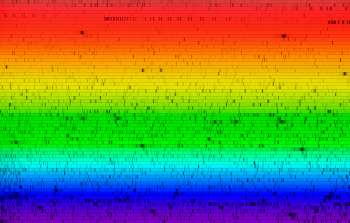sci21074 — Announcement
WIYN’s NEID Begins its Mission of Exoplanet Discovery
July 30, 2021
A new tool for the discovery of planets beyond the Solar System, NEID has begun its science mission at the WIYN 3.5m Telescope at KPNO. NEID will also acquire extensive spectra of the Sun that will be made public immediately.
The NEID spectrometer, a new tool for the discovery of planets beyond the Solar System, has begun its scientific mission at the WIYN 3.5m Telescope at Kitt Peak. The newest and one of the most precise radial velocity spectrometers ever built, NEID will discover exoplanets by measuring the minute gravitational tug of exoplanets on their host star. NEID will also acquire extensive spectra of the Sun to understand how to calibrate out the effects of stellar activity in order to detect the lowest mass exoplanets. All solar spectra are publicly available as soon as they are reduced.
Earlier this month, the NEID team announced the end of the instrument’s extensive commissioning process and the start of full science operations. Following its first light announcement in January 2020 and the recent completion of its successful final NASA review, NEID now begins its full science mission as a tool for scientific discovery. NEID is available to the worldwide astronomical community through the NOIRLab time allocation process and has been available, to a limited extent, in shared risk mode since Semester 2020B.
“We have reached an exciting milestone for NEID,” said NEID instrument scientist Sarah Logsdon (NOIRLab). “After an extensive commissioning process, where the instrument was put through its paces, NEID is now embarking on its science mission, having demonstrated that it is indeed a state-of-the-art tool for studying planets outside of our Solar System.”
Built as part of the joint NSF-NASA program NN-EXPLORE, NEID’s mission is to enable some of the highest precision measurements currently possible, as well as to attempt to chart a path to the discovery of terrestrial planets around other stars. The instrument’s single measurement precision is already impressive, better than 0.25 m/s. In comparison, the gravitational tug of Jupiter on the Sun induces a huge 13 m/s “wobble” in the Sun’s radial velocity; the Earth induces a wobble of only about 0.09 m/s.
Navigating a Pandemic
The COVID-19 pandemic introduced additional complexity to the already challenging task of commissioning a state-of-the-art instrument.
For example, a major commissioning goal for NEID was to prove both short- and long-term instrumental stability. While the team had made a lot of progress in the initial round of commissioning, a seven-month COVID-related shutdown in Spring 2020 meant that the team had to restart the clock toward proving long-term stability when the instrument was restarted after the shutdown.
To pass its final NASA review, NEID needed to demonstrate that each of its major subsystems met their requirements. These included the thermal stability of the NEID cleanroom, the stellar acquisition and guiding performance of the Port Adapter, and most importantly, the requirement on the instrument’s radial velocity precision (27 cm/s), which it surpassed!
“NEID has been the incredible story of a team that has delivered, in record time of a little over four years that includes seven months of stoppage for COVID and then working through the height of this pandemic, an instrument that sets a new standard and will produce breakthrough science,” said WIYN Executive Director, Jayadev Rajagopal.
Using NEID, astronomers are expected to discover new rocky planets, measure the compositions of exoplanetary atmospheres, the shapes and orientations of planetary orbits, and characterize the physical processes of a planet’s host star. Jason Wright, Penn State University professor and NEID project scientist said, “I can’t wait to see the results we and our colleagues around the world will produce over the next few years.”
Working Day and Night
While NEID will search for orbiting exoplanets at night, it will also observe the Sun during the day in order to address one of the major challenges facing the detection of low mass exoplanets: our understanding of stellar activity.
The seething convection on a star’s surface, threaded by invisible lines of magnetic force and marred by ever changing active regions and starspots, can mimic or obscure true exoplanet-induced radial velocity signals. To meet this challenge, astronomers are turning to observations of a star for which we know the answer, because we know exactly how many planets orbit it—our Sun! When it is done studying stars at night, NEID will study the Sun using a special smaller solar telescope that the team has developed.
“Thanks to the NEID solar telescope funded by the Heising-Simons Foundation, NEID won’t sit idle during the day,” said Eric Ford, professor of astronomy and astrophysics and director of Penn State’s Center for Exoplanets and Habitable Worlds. “It will carry out a second mission, collecting a unique dataset that will enhance the ability of machine learning algorithms to recognize the signals of low-mass planets in stellar spectra.”
As of a few weeks ago, solar spectra captured by NEID are publicly released immediately following data reduction via the NExScI NEID Solar Radial Velocity Archive. Each spectrum has an exposure time of 55 s, and on a clear day upwards of 200 frames are acquired. The solar spectra are reduced using the same pipeline used for the stellar spectra.
NEID’s solar telescope marks the return of solar observations to Kitt Peak.
“The Sun points the way,” said Suvrath Mahadevan, Penn State University professor and principal investigator of NEID. “For decades, the iconic and now decommissioned McMath-Pierce telescope at Kitt Peak was the premier facility for studying the Sun. NEID is now the bridge that connects exoplanet science to solar observations, the Sun to the stars, and a bridge that connects Kitt Peak’s history to its present and future.”
—This article was adapted from a press release written by Sam Sholtis (Penn State University)
About the Announcement
| Id: |
ID
sci21074
|
